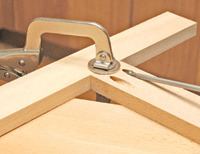 | ||
Pocket-hole joinery, or pocket-screw joinery, involves drilling a hole at an angle — usually 15 degrees — into one workpiece, and then joining it to a second workpiece with a self-tapping screw. The technique, in addition to doweling, is said to have its roots in ancient Egypt, although much doubt is thrown on this theory. Older woodworking reference books never mention the technique of pocket-hole joinery and contemporary woodworking references describe it as new and nontraditional.
Contents
Benefits
Drawbacks
References
Pocket-hole joinery Wikipedia(Text) CC BY-SA
